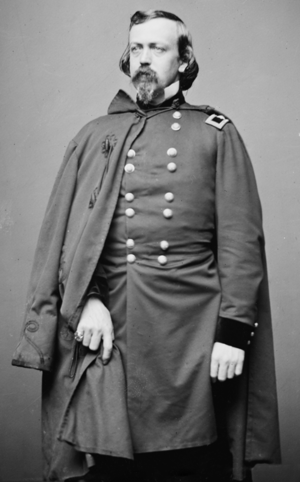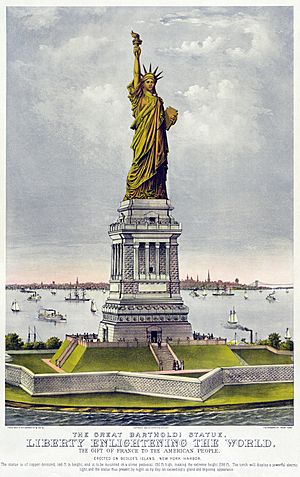Charles Pomeroy Stone facts for kids
Quick facts for kids
Charles Pomeroy Stone
|
|
|---|---|
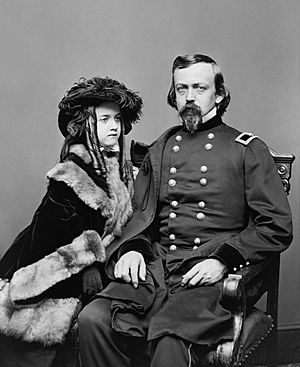
Charles Pomeroy Stone and his daughter Esther, who was known as Hettie, photographed together in the spring of 1863; Stone's USMA class ring can be seen on the little finger of his right hand.
|
|
| Born | September 30, 1824 Greenfield, Massachusetts |
| Died | January 24, 1887 (aged 62) New York City, New York |
| Place of burial |
West Point Cemetery
|
| Allegiance | United States of America Khedivate of Egypt |
| Service/ |
United States Army Egyptian Army |
| Years of service | 1845–1856, 1861–1864 (USA) 1870–83 (Egypt) |
| Rank | Lieutenant General (Egypt) |
| Commands held | Benicia Arsenal Defenses of Washington, D.C. 14th Infantry Regiment Corps of Observation Chief of Staff, Army of the Gulf Chief of Staff, Egyptian Army |
| Battles/wars | Mexican–American War American Civil War |
| Signature | |
Charles Pomeroy Stone (born September 30, 1824 – died January 24, 1887) was an American Army officer, engineer, and surveyor. He fought bravely in the Mexican–American War, earning special promotions for his actions. After leaving the Army for a while to work for the Mexican Government, he rejoined to fight in the American Civil War.
Stone was known as one of the first volunteers to join the Union Army. During the Civil War, he became a general. He is remembered for his role in the Battle of Ball's Bluff in October 1861. After the Union lost this battle, Stone was blamed and arrested. He was held in prison for nearly six months without a trial, mostly due to political reasons. After his release, he did not hold a major command again during the war. Later, Stone served as a general in the Egyptian Army. He is also famous for helping to build the base of the Statue of Liberty.
Contents
Early Life and Education
Charles Pomeroy Stone was born in Greenfield, Massachusetts. His father, Alpheus Fletcher Stone, was a doctor in the town. Charles was one of ten children in his family.
In 1841, when he was 17, he entered the United States Military Academy at West Point. He graduated four years later, ranking seventh in his class of 41 cadets. Many of his classmates would later become important figures in the Civil War. After graduating, he became a second lieutenant in the Army.
Military and Civilian Work
Early Army Career
After West Point, Stone stayed there for a short time as an assistant professor. He taught subjects like geography, history, and ethics. In 1846, he was sent to the Watervliet Arsenal in New York and then to Fort Monroe in Virginia. At these places, he worked with weapons and military supplies.
Fighting in Mexico
Stone fought in the Mexican–American War under Maj. Gen. Winfield Scott. He was promoted to second lieutenant in March 1847. He took part in several important battles, including the siege of Veracruz and the Battle of Molino del Rey. For his brave actions at Molino del Rey, he was promoted to first lieutenant.
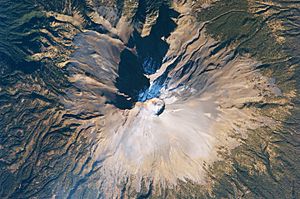
In September 1847, Stone fought in the Battle of Chapultepec. He was promoted to captain for his courage that day. After the fighting in Mexico City, he was part of a group that climbed the Popocatépetl volcano. They even raised an American Flag at the top!
Life on the Pacific Coast
After the war, Stone returned to his work with military supplies. He then took a break from the Army to travel in Europe. He spent two years studying how other armies operated. In 1851, he was put in charge of military supplies for the Pacific Department. During this time, he also started building the Benicia Arsenal in California. He was promoted to first lieutenant in 1853.
Marriage and New Jobs
In 1853, Stone married Maria Louisa Clary. Her father was also a military officer.
In 1856, Stone decided to leave the U.S. Army because he felt the pay was not enough for his family. He tried working as a banker in San Francisco, but the bank failed. So, he moved back to Mexico. From 1857 to 1860, he worked as a surveyor, mapping out parts of Mexico. He also served as a temporary consul (a government representative) in Guaymas, Mexico. In 1860, he moved his family back to Washington, D.C..
The American Civil War
When the Civil War began, Stone was in Washington. He was asked to become the Inspector General of the District of Columbia Militia. He was one of the first volunteer officers to join the Union Army. In this role, he helped secure Washington for the arrival of Abraham Lincoln, the new president. He was also in charge of security for Lincoln's inauguration.
Stone helped stop a secret plot by some Southern groups to take over Washington during the inauguration. He quickly acted to investigate and disarm these groups, protecting the new president.
In May 1861, Stone became a colonel. In August, he was promoted to brigadier general. He commanded a group of soldiers guarding the Potomac River.
Disagreements and Trouble
General Stone believed in following all military orders and laws. This sometimes caused problems with powerful politicians from his home state of Massachusetts. For example, he ordered his soldiers not to encourage slaves to run away and even returned some runaway slaves. This was in line with the laws at the time. However, many of his soldiers and politicians like Governor John Albion Andrew and Senator Charles Sumner were abolitionists who wanted to end slavery.
This led to angry letters between Stone and Governor Andrew. Senator Sumner also spoke out against Stone in the U.S. Senate. These disagreements would cause serious problems for Stone later on.
The Battle of Ball's Bluff
On October 20, 1861, General Stone received orders from Maj. Gen. George B. McClellan. He was told to send soldiers across the Potomac River to see what the Confederate forces were doing near Leesburg, Virginia. McClellan hoped this action would make the Confederates leave the area without a fight.
Stone sent a small group of soldiers across the river. They reported seeing what they thought was a Confederate camp. Based on this, Stone decided to investigate further. He sent Colonel Charles Devens and 300 men to cross at Ball's Bluff that night to attack the camp at daybreak. Stone also ordered more troops, including Colonel Edward Dickinson Baker (who was also a U.S. Senator), to cross and take overall command.
However, the "camp" turned out to be just corn shocks in the shadows. Devens found no camp and waited for more orders. Skirmishes (small fights) began before Baker arrived.
The Confederate commander, Colonel Nathan George Evans, divided his forces. While some of his men blocked Stone's main group, the rest fought and defeated Baker's soldiers at Ball's Bluff. Stone didn't know how bad the situation was at Ball's Bluff because Baker didn't send updates. When Stone's path was blocked, he returned to Edwards Ferry. He then learned about the terrible defeat at Ball's Bluff.
The Union Army lost about 1,000 men in this battle, including Senator Baker, who was killed. The Confederates lost far fewer soldiers. Senator Baker's death caused a huge outcry in Washington.
Arrest and Imprisonment
After Ball's Bluff, General Stone faced a lot of public criticism. The U.S. Congress formed a special committee to investigate the war. Stone was one of the first people they questioned, but his testimony was kept secret.
Stone's official report about the battle was leaked to a newspaper. In it, he praised Baker's bravery but also pointed out his mistakes as a commander. Baker's political friends, including Governor Andrew and Senator Sumner, were very angry. They started blaming Stone, not Baker. Stone's loyalty to the Union and his views on slavery were questioned more than his military skills.
If he is a traitor I am a traitor, and we are all traitors.
Stone was arrested just after midnight on February 8, 1862. He was taken to the military prison at Fort Lafayette. He was put in solitary confinement (alone in a cell). No official charges were ever filed against him, and he never had a trial. This was against military rules.
Stone's health suffered in prison. His doctors protested, and he was moved to Fort Hamilton, where he could exercise. He spent 50 days in Fort Lafayette and 139 days in Fort Hamilton.
To hold one commander in prison untried is less harmful in times of great national distress than to withdraw several good officers from active battlefields to give him a trial.
Finally, Stone was released on August 16, 1862, without any explanation or apology. His release was due to a new law passed by Congress. This law said that charges must be filed within eight days of an arrest, and a trial must happen within 30 days. This law applied to Stone's case.
After Release
After his release, Stone returned to Washington and tried to clear his name. In early 1863, he was finally allowed to explain his side of the story to the committee. He answered their questions, and they eventually cleared his name. The New York Times newspaper wrote that Stone had suffered a "most flagrant wrong."
Stone was then sent to the Department of the Gulf. He served as a chief of staff for Maj. Gen. Nathaniel P. Banks. However, in April 1864, he was removed from his volunteer general's rank and returned to his regular army rank of colonel. He briefly commanded a brigade during the siege of Petersburg. He finally resigned from the Army on September 13, 1864, before the war ended.
Later Life and Legacy
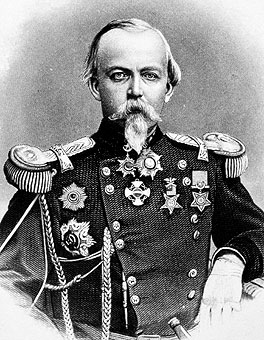
After the American Civil War ended in 1865, Stone worked as an engineer for a mining company. In 1870, William Tecumseh Sherman, a famous U.S. Army general, recommended Stone for service in the Egyptian Army.
From 1870 to 1883, Stone served as the chief of staff for the leader of Egypt, Isma'il Pasha. He was given the high rank of lieutenant general and the title of "Ferik Pasha." Stone did a great job in Egypt. He helped create a general staff for the army, expanded Egypt's borders, and set up schools for soldiers and their children.
Stone later returned to the United States. In 1884, he became the Chief Engineer for the Statue of Liberty project in New York Harbor. He planned and oversaw the building of the Statue of Liberty's pedestal (base) and its concrete foundation. He also supervised putting the huge statue back together after it arrived from France. Stone was the grand marshal (leader) of the dedication parade for the Statue of Liberty in Manhattan on October 28, 1886.
He became ill a few months later and died in New York City in 1887. General Stone is buried in West Point Cemetery.
Stone's first wife, Maria, died in Washington, D.C. After that, he married Jeanne Stone, and they had two daughters and a son. His son, John Stone Stone, became a pioneer in wireless telegraphy (early radio).
Many historians believe that Stone was treated unfairly after the Battle of Ball's Bluff. They say his arrest and imprisonment were a major injustice in American military history.
Images for kids


